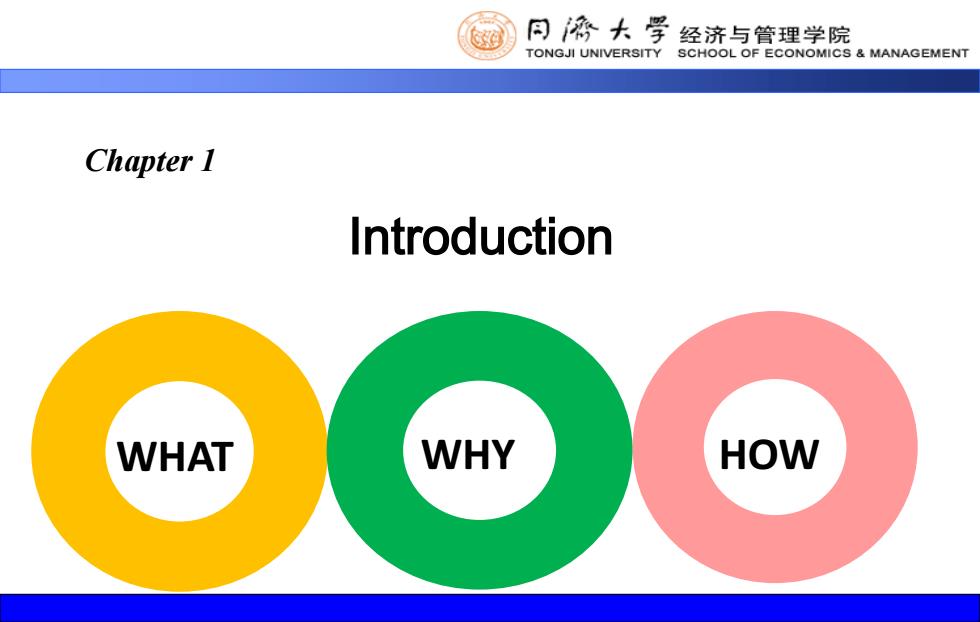
9 同济大学 经济与管理学院 TONGJI UNIVERSITY SCHOOL OF ECONOMICS MANAGEMENT Chapter I Introduction WHAT WHY HOW
WHAT WHY HOW Chapter 1 Introduction
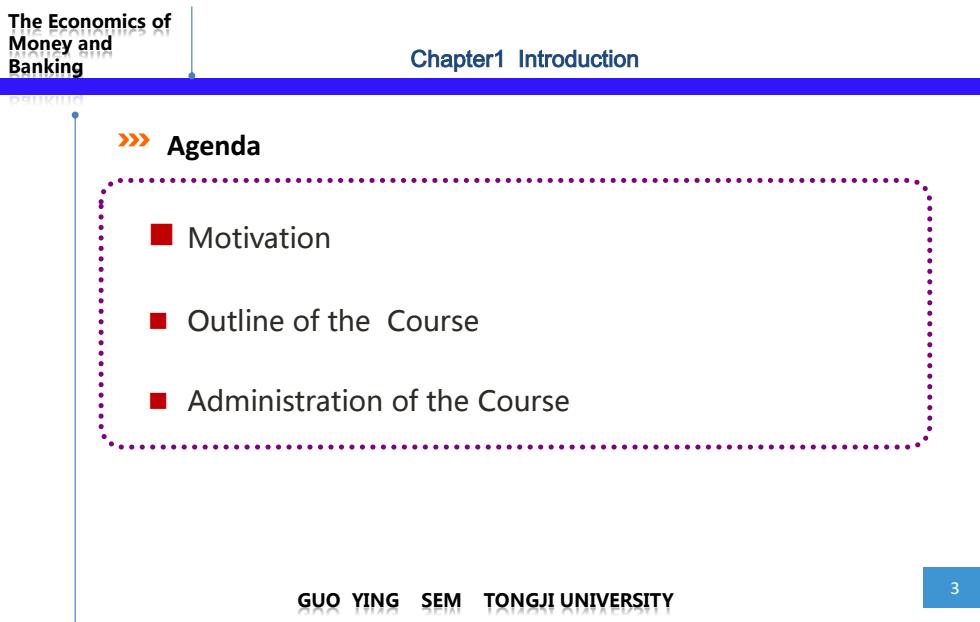
The Economics of Money and Banking Chapter1 Introduction 》Agenda ■ Motivation ● ● ■ Outline of the Course Administration of the Course 3 GUO YING SEM TONGJI UNIVERSITY
The Economics of Money and Banking 3 GUO YING SEM TONGJI UNIVERSITY Motivation Outline of the Course Administration of the Course Chapter1 Introduction Agenda

The Economics of Money and Banking Chapter1 Introduction Where industry treads,finance will follow. : ------Joan Robinson,famous female economist : : The success of other market reform depends on the health of the financial system. ● : ------World Bank,World Development Report,1996 : The Word Bank ● Group 4 GUO YING SEM T TONGJI UNIVERSITY
The Economics of Money and Banking 4 GUO YING SEM TONGJI UNIVERSITY Where industry treads, finance will follow. ------Joan Robinson, famous female economist The success of other market reform depends on the health of the financial system. ------World Bank, World Development Report, 1996 Chapter1 Introduction

The Economics of Money and Banking Chapter1 Introduction What is finance? ↓ Currency or fund The study of funds management,or the allocation of assets and liabilities over time Financial instruments under conditions of certainty and uncertainty. Financial institutions -----wiki Financial markets Regulatory agencies Central banks 5
The Economics of Money and Banking 5 GUO YING SEM TONGJI UNIVERSITY What is finance? Chapter1 Introduction The study of funds management, or the allocation of assets and liabilities over time under conditions of certainty and uncertainty. -----wiki Currency or fund Financial instruments Financial institutions Financial markets Central banks Regulatory agencies
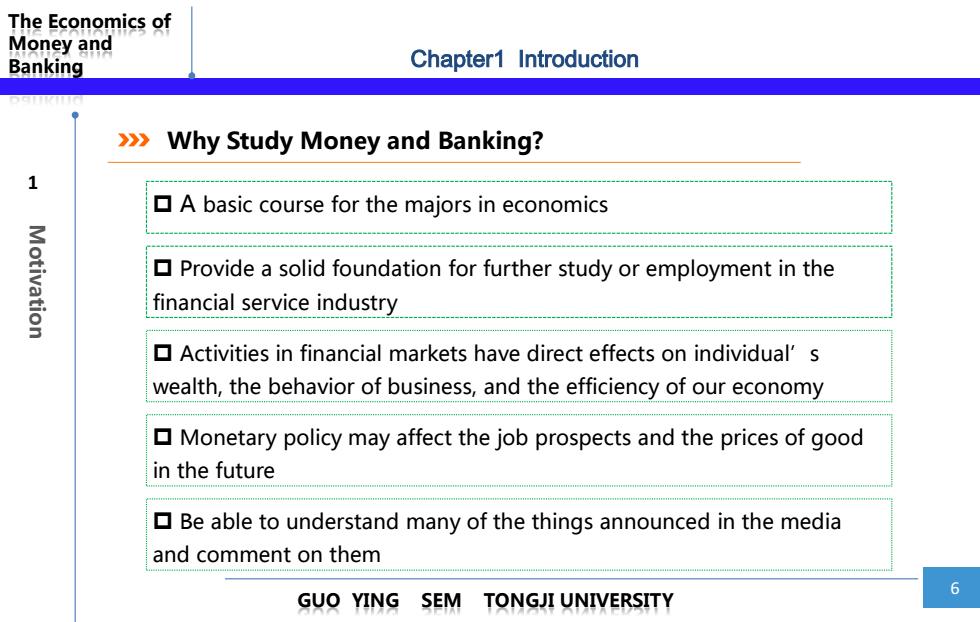
The Economics of Money and Banking Chapter1 Introduction 》》》 Why Study Money and Banking? 1 A basic course for the majors in economics Motivation Provide a solid foundation for further study or employment in the financial service industry Activities in financial markets have direct effects on individual's wealth,the behavior of business,and the efficiency of our economy Monetary policy may affect the job prospects and the prices of good in the future Be able to understand many of the things announced in the media and comment on them 6 GUO YING SEM TONGJI UNIVERSITY
The Economics of Money and Banking 6 GUO YING SEM TONGJI UNIVERSITY Motivation 1 Chapter1 Introduction Why Study Money and Banking? Provide a solid foundation for further study or employment in the financial service industry Activities in financial markets have direct effects on individual’s wealth, the behavior of business, and the efficiency of our economy Monetary policy may affect the job prospects and the prices of good in the future Be able to understand many of the things announced in the media and comment on them A basic course for the majors in economics

The Economics of Money and Banking Chapter1 Introduction >>Course Description 2 The course is the bilingual course on the economics of money,banking and financial markets.It examines concepts and practices of money and banking in the real world.Various aspects of finance are discussed including currency, Outline of the course monetary system,financial instruments,financial institutions,financial markets and financial supervision system,etc. China's experience and lessons of money and banking will be highlighted in the course.How China's financial system grew and how the current financial issue came into people's attention will be addressed.Of course the international comparison in these issues are very important in this course, which broadening the students'global vision from diversified angles and deepening the understanding of financial system in different nations. GUO YING SEM TONGJI UNIVERSITY
The Economics of Money and Banking 7 GUO YING SEM TONGJI UNIVERSITY Outline of the course 2 Chapter1 Introduction Course Description The course is the bilingual course on the economics of money, banking and financial markets. It examines concepts and practices of money and banking in the real world. Various aspects of finance are discussed including currency, monetary system, financial instruments, financial institutions, financial markets and financial supervision system, etc. China’s experience and lessons of money and banking will be highlighted in the course. How China’s financial system grew and how the current financial issue came into people’s attention will be addressed. Of course the international comparison in these issues are very important in this course, which broadening the students’ global vision from diversified angles and deepening the understanding of financial system in different nations

The Economics of Money and Banking Chapter1 Introduction 》》( Course Objectives 2 The course is structured to provide the students with an integrated perspective on the economics of money and banking especially in China.It Outline of the course outlines those elements of the subject that: What are the functions of currency and monetary system? How do credit and interest rate work in the real world What are the roles of financial institutions and markets in the financial system? How does monetary policy work in the real world? How and why did China go onto a new path of financial reform? What is the future for China's financial system? GUO YING SEM TONGJI UNIVERSITY 8
The Economics of Money and Banking 8 GUO YING SEM TONGJI UNIVERSITY Outline of the course 2 Chapter1 Introduction Course Objectives The course is structured to provide the students with an integrated perspective on the economics of money and banking especially in China. It outlines those elements of the subject that: What are the functions of currency and monetary system? How do credit and interest rate work in the real world ? What are the roles of financial institutions and markets in the financial system? How does monetary policy work in the real world? How and why did China go onto a new path of financial reform? What is the future for China’s financial system?
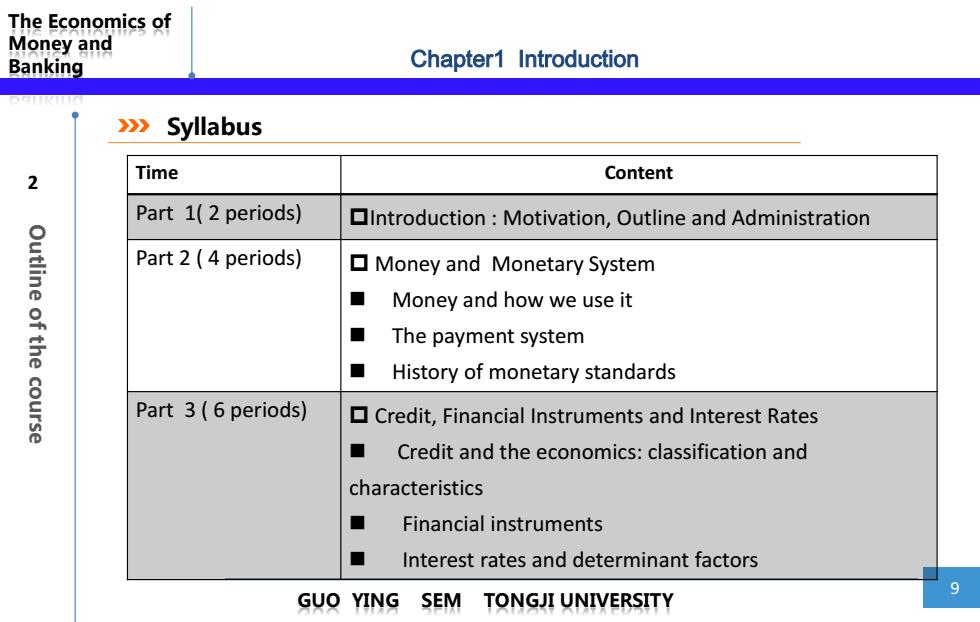
The Economics of Money and Banking Chapter1 Introduction >>>Syllabus 2 Time Content Part 1(2 periods) Introduction Motivation,Outline and Administration Part 2(4 periods) Outline of the course Money and Monetary System ■ Money and how we use it ■ The payment system ■ History of monetary standards Part 3(6 periods) Credit,Financial Instruments and Interest Rates ■ Credit and the economics:classification and characteristics ■ Financial instruments ■ Interest rates and determinant factors 9 GUO YING SEM TONGJI UNIVERSITY
The Economics of Money and Banking 9 GUO YING SEM TONGJI UNIVERSITY Outline of the course 2 Chapter1 Introduction Syllabus Time Content Part 1( 2 periods) Introduction : Motivation, Outline and Administration Part 2 ( 4 periods) Money and Monetary System Money and how we use it The payment system History of monetary standards Part 3 ( 6 periods) Credit, Financial Instruments and Interest Rates Credit and the economics: classification and characteristics Financial instruments Interest rates and determinant factors
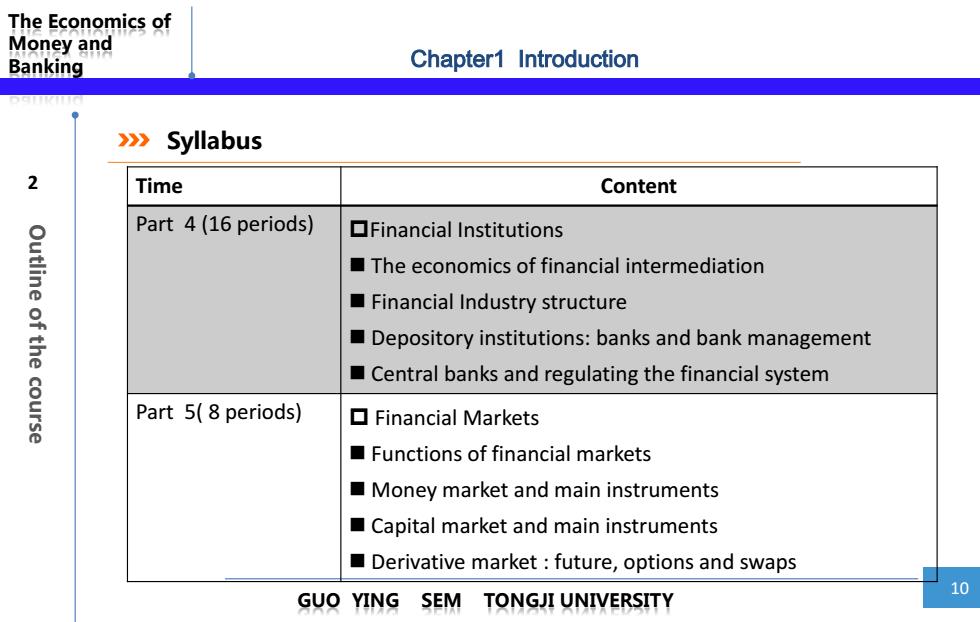
The Economics of Money and Banking Chapter1 Introduction >>>Syllabus 2 Time Content Part 4(16 periods) Financial Institutions Outline of the course The economics of financial intermediation Financial Industry structure Depository institutions:banks and bank management Central banks and regulating the financial system Part 5(8 periods) ▣Financial Markets Functions of financial markets Money market and main instruments Capital market and main instruments Derivative market:future,options and swaps GUO YING SEM TONGJI UNIVERSITY 10
The Economics of Money and Banking 10 GUO YING SEM TONGJI UNIVERSITY Outline of the course 2 Chapter1 Introduction Syllabus Time Content Part 4 (16 periods) Financial Institutions The economics of financial intermediation Financial Industry structure Depository institutions: banks and bank management Central banks and regulating the financial system Part 5( 8 periods) Financial Markets Functions of financial markets Money market and main instruments Capital market and main instruments Derivative market : future, options and swaps
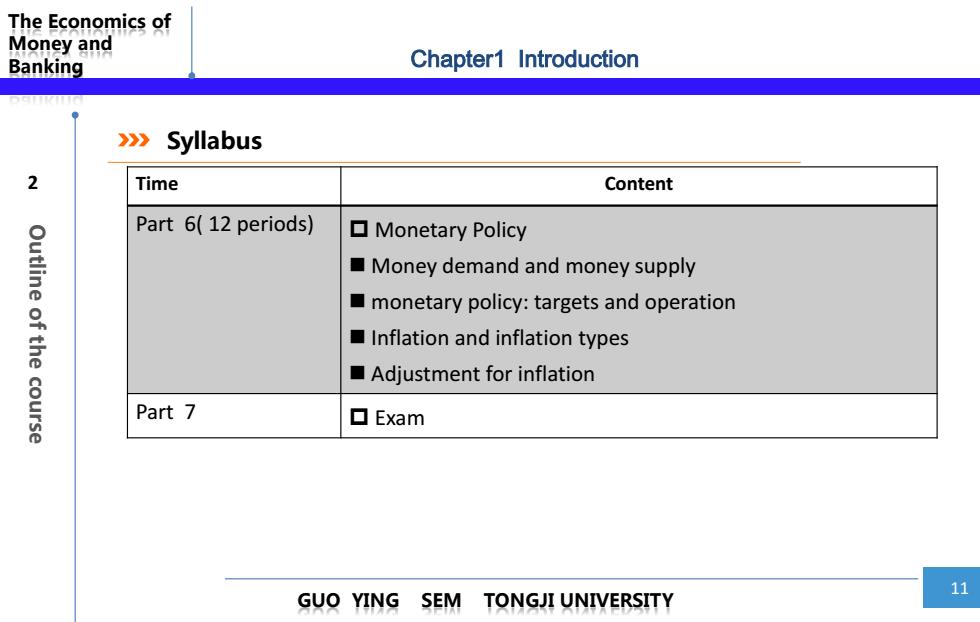
The Economics of Money and Banking Chapter1 Introduction 》 Syllabus 2 Time Content Part 6(12 periods) ▣Monetary Policy Outline of the course Money demand and money supply monetary policy:targets and operation Inflation and inflation types Adjustment for inflation Part 7 ▣Exam GUO YING SEM 11 TONGJI UNIVERSITY
The Economics of Money and Banking 11 GUO YING SEM TONGJI UNIVERSITY Outline of the course 2 Chapter1 Introduction Syllabus Time Content Part 6( 12 periods) Monetary Policy Money demand and money supply monetary policy: targets and operation Inflation and inflation types Adjustment for inflation Part 7 Exam